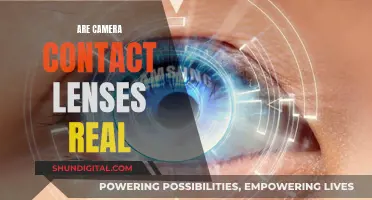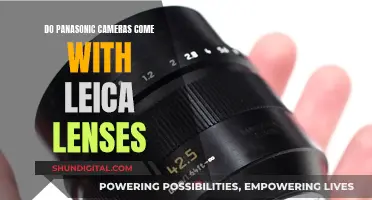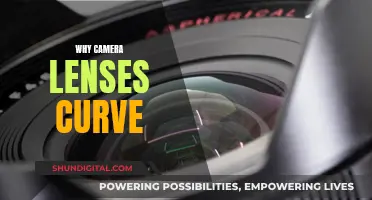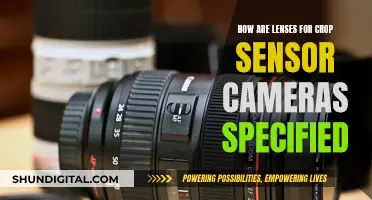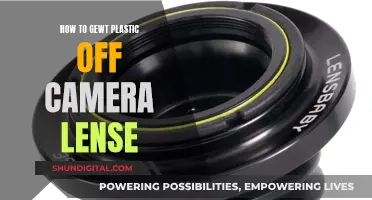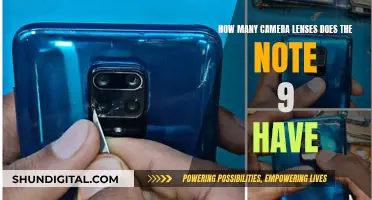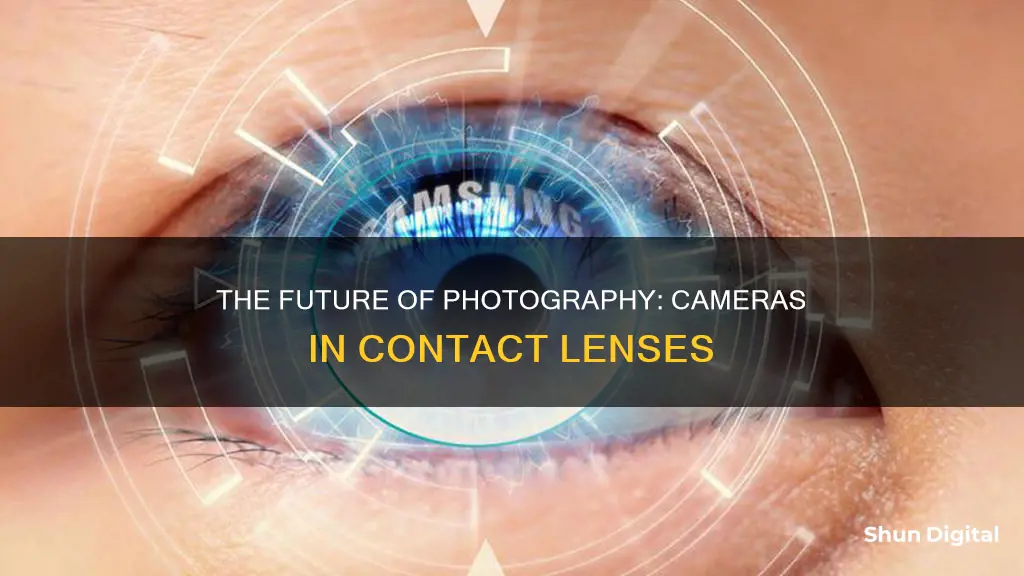
Smart contact lenses with built-in cameras are no longer a futuristic concept. Tech giants like Google, Samsung, and Sony have been working on developing this technology since as early as 2012. While these smart contact lenses are not available to the general public yet, the technology to create them is almost here. These lenses will be able to do everything from recording video to monitoring the wearer's health. The applications of this technology are endless, from helping the visually impaired to improving performance in sports. However, there are also concerns about privacy and data security that will need to be addressed as this technology moves forward.
| Characteristics | Values |
|---|---|
| Purpose | To provide enhanced vision, data access, and health monitoring |
| Functionality | Camera, on-board memory, display, controller, wireless data transmission, and power |
| Control | Blinking and eye movement |
| Power | Wireless |
| Target Users | People with visual impairments, consumers, law enforcement, military, medical professionals |
| Applications | Entertainment, policing, industrial, security, health monitoring, facial recognition |
| Concerns | Privacy, data security, safety, power delivery, comfort |
| Status | Prototypes and patents exist, but not commercially available yet |
What You'll Learn

Camera contact lenses
Google's smart contact lens includes a tiny CMOS camera sensor located just below the pupil, a control circuit, and a method of receiving power wirelessly. The camera's position ensures it naturally follows the wearer's gaze, making it ideal for facial recognition and early warning systems. The camera could also provide superhuman abilities, such as telescopic vision and infrared/night vision. While the lens itself cannot process images, it can stream them to a nearby smartphone or head-mounted display for real-time analysis.
Sony has also proposed a camera contact lens with on-board memory, a camera controller, wireless data transmission, and wireless power. Like Google's lens, Sony's version would be triggered by blinking, distinguishing between natural and deliberate blinks by measuring the duration of the blink. While not much information is available about Sony's patent, it is easy to imagine its potential use in entertainment, policing, and security.
Samsung has also filed patents for contact lenses with a display, built-in camera, and sensors controlled by blinking. In addition, Mojo Vision is developing a smart contact lens with a MicroLED display, eye tracking, and motion-tracking technology. The Mojo Lens aims to assist people with visual impairments and provide an augmented reality experience.
While these innovations are exciting, there are valid concerns about privacy, data security, and safety. The social implications of such technology could be significant, and new legislation will likely be required to address these issues. Nevertheless, camera contact lenses have the potential to revolutionize various industries and enhance our understanding of the world.
Understanding Camera Lenses: Converging or Diverging?
You may want to see also

Health monitoring
Smart contact lenses are being developed for health monitoring purposes, with applications for people with chronic diseases, visual impairments, and diabetes.
Glaucoma
New studies are testing lenses that can track the progress of glaucoma with tiny sensors. The Triggerfish sensor is an FDA-approved device that helps determine treatment for glaucoma. The contact lens is worn for a 24-hour period, providing eye pressure and other data.
Diabetes
Google announced in 2014 that it was working on a smart contact lens for diabetics that provides a real-time glucose level reading from your tears. In 2020, researchers in South Korea announced a working glucose-sensing contact lens with successful animal trial data. This version transmits wirelessly to a nearby device and sends alerts when glucose levels are out of range.
Allergies
Acuvue Theravision is now FDA-approved for daily use to treat itchy eyes due to allergies.
Visual Impairments
Mojo Vision is taking wearable technology to the next level with its smart contact lenses. The Mojo Lens will help people with visual impairments navigate the world more easily and safely. The ability to zoom, adjust contrast, track motion, and provide captions are all part of the prototype. Mojo Vision is also working on having these lenses work as medically approved assistive vision devices.
Biometric Data
Smart contact lenses could be a crucial part of care plans for patients with chronic diseases—a non-invasive technology able to collect and record biometric data continuously and alert doctors wirelessly if anything seems amiss.
Camera Lenses: Do They Age Like Wine or Rust?
You may want to see also

Facial recognition
Smart contact lenses with built-in cameras are no longer a futuristic concept. In 2012, Google filed a patent for a contact lens with a camera, specifically mentioning applications such as facial recognition, infrared vision, and seeing in the dark. Since then, Samsung and Sony have also filed similar patents.
Google's smart contact lens features a tiny CMOS camera sensor positioned just below the pupil, a control circuit, and a wireless power source. The camera would be placed near the edge of the lens to avoid obscuring the wearer's vision. One of the key advantages of this technology is that the camera would naturally follow the wearer's gaze, enabling a wide range of applications.
The potential benefits of this technology are far-reaching. For instance, it could be used to identify criminals or wanted individuals, enhancing public safety. Additionally, it could be used in medical settings to identify patients and ensure they receive the correct treatment.
However, there are also valid concerns about the implications of this technology for privacy and data security. The very nature of smart contact lenses with cameras raises questions about how to regulate privacy if these devices become mainstream. The knowledge that one's actions could be recorded at any time may significantly impact social norms and behaviours.
Furthermore, there are technical challenges to be addressed, such as power delivery and data transmission, as well as ensuring the safety of placing a wireless device in close proximity to sensitive organs like the eyes.
While the potential benefits of smart contact lenses with facial recognition capabilities are vast, it is essential to carefully consider and address the associated ethical, legal, and technical implications before widespread adoption can be considered.
Q-See Camera Lenses: Plastic or Glass?
You may want to see also

Privacy concerns
The prospect of contact lenses with built-in cameras raises several privacy concerns. The covert nature of these lenses makes them particularly concerning, as they could enable clandestine photography and surveillance in public and semi-public places, such as restrooms. This could lead to violations of privacy, stalking laws, and the potential for intimate interactions to be recorded without consent. Additionally, these lenses may be susceptible to hacking, involuntary use, or malfunction.
The use of contact lenses with facial recognition technology by law enforcement or government agencies is another area of concern. This could lead to increased surveillance and the potential for misuse of power. As seen in China, this technology could be used to identify and track journalists, activists, and other individuals on government blacklists.
The widespread adoption of smart contact lenses could also impact social norms and interactions. People may become worried that they are being recorded at all times, leading to a sense of paranoia and distrust. Additionally, individuals could secretly run searches or look up information about the person they are talking to during a conversation, potentially distorting perceptions of in-person intimacy and connection.
The implications of this technology are far-reaching and will likely require new legislation to address privacy and security concerns.
Universal Camera Lenses: A Myth or Reality?
You may want to see also

Augmented reality
Smart contact lenses are being developed by several companies, including Google, Sony, Samsung, Mojo Vision, and Innovega. These lenses have a wide range of applications, including augmented reality (AR) and virtual reality (VR).
Mojo Vision's smart contact lens is a notable example, as it aims to replace smartphones, smartwatches, AR glasses, and VR headsets. The lens features a MicroLED display, eye tracking, and a battery array. It connects with an external controller, such as a necklace, that houses the compute functions. The Mojo Lens aims to provide an immersive AR experience, with content that can be locked into the wearer's field of vision.
Google has also developed a smart contact lens with an integrated camera. The camera's position near the edge of the lens allows it to follow the wearer's gaze, enabling applications such as facial recognition and infrared/night vision.
Samsung and Sony have also filed patents for contact lenses with displays and built-in cameras. These lenses can project images directly into the wearer's eyes and are controlled by blinking.
Innovega is developing a system that combines smart contact lenses and glasses. The soft contact lenses can be worn as regular prescription lenses, while the paired glasses provide a heads-up display. This setup is designed to reduce eye strain by mimicking natural eye movements and depth of field.
The potential impact of these technologies on social interactions and norms is significant. With discreet access to the internet and the ability to run searches or view content without others knowing, these smart lenses could distort perceptions of in-person intimacy and connection. Additionally, privacy and data security concerns will need to be addressed as this technology advances.
Lens and Camera Compatibility: Universal Fit or Not?
You may want to see also
Frequently asked questions
Camera contact lenses don't exist on the market yet, but they are getting closer to becoming a reality. Google, Samsung, and Sony have all filed patents for contact lenses with camera capabilities.
Camera contact lenses can record video and take pictures of whatever the wearer is looking at. They can also be used for facial recognition, infrared vision, and early warning systems.
It's hard to say when camera contact lenses will be available to the public. The technology is almost there, but there are still challenges to overcome regarding engineering, medical approval, and market value.


